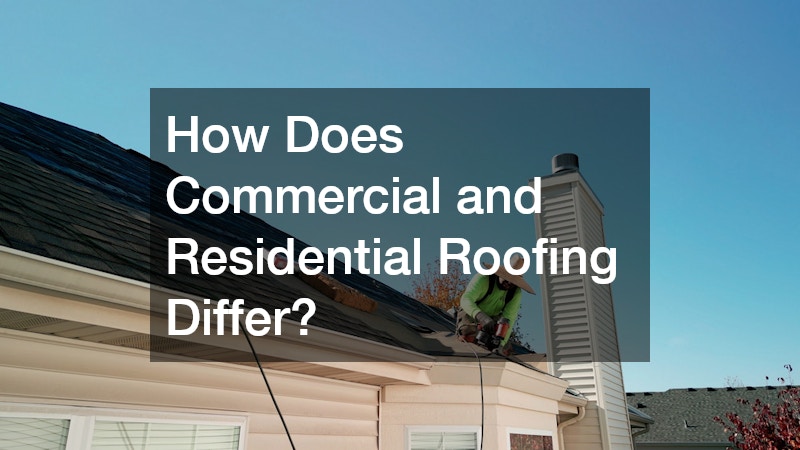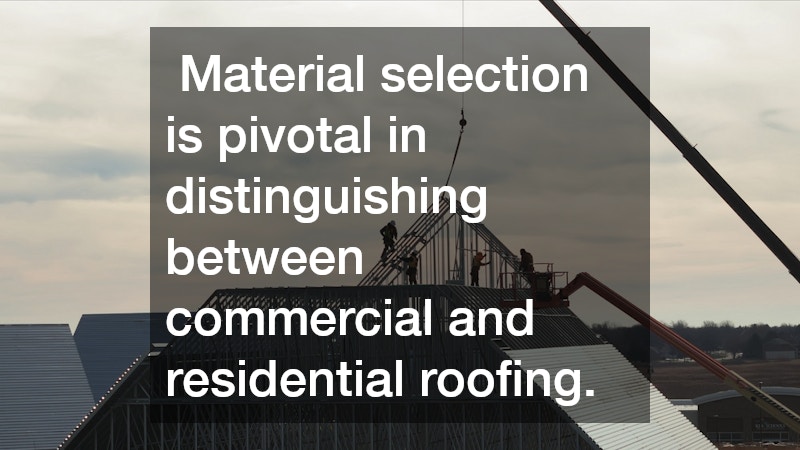

Roofing, though often overlooked, is a crucial component of any building. Distinction between commercial and residential roofing is essential for understanding their specific requirements and applications. This article provides insights into how commercial and residential roofing differ based on structure, material, and installation techniques. By examining these differences, property owners and contractors can make informed decisions to suit their particular needs. As we explore these roofing types, consider how each caters uniquely to its environment and function.
Residential roofing primarily focuses on single-family homes and smaller apartment buildings, while commercial roofing handles large-scale structures. The purpose behind specific roofing applications greatly affects the choices of materials and construction methods. Residential buildings, often reflecting personal aesthetic preferences, use materials such as asphalt, wood, or metal. Commercial buildings prioritize function and energy efficiency, frequently utilizing more robust materials like metal, single-ply, and built-up roofing systems. Understanding these foundational elements sets the stage for deeper exploration of their differences.
Furthermore, the different types of loads that these roofs bear highlight how distinct they are. Commercial roofs must support additional equipment such as HVAC systems and solar panels, while residential roofs primarily manage environmental loads like snow and rain. The disparity in structure and function dictates many aspects, from roofing design to long-term maintenance. Recognizing these initial differences guides further conversation on how various roofing features are tailored to their respective environments. With this foundational understanding, we can delve into more detailed distinctions.
Material Selection and Design
Material selection is pivotal in distinguishing between commercial and residential roofing. For residential roofs, aesthetics often drive material choices, with homeowners opting for shingles that complement their house’s design. Materials like asphalt shingles, wood shakes, slate, and clay tiles are common due to their visual appeal and availability. Commercial roofs, however, focus more on durability and functionality, utilizing materials like rubber, thermoplastic, or metal sheets. These materials are chosen not for looks but for their ability to withstand harsher conditions and support heavy equipment.
The design intricacies also significantly differ between these roofing types. Residential roofs generally have steeper slopes leading to easier water runoff and a classic appearance beneficial for residential aesthetics. In contrast, commercial roofs are often flat or have a low slope, aiding the placement of equipment and maximizing space for functional purposes. This design suits commercial needs but necessitates efficient water drainage systems, highlighting another critical difference. The slope not only affects appearance but also impacts maintenance and materials, with steeper roofs requiring specific considerations.
Additionally, structural considerations differ markedly, influenced by these design choices. Residential roofing structures are typically simpler, with pre-engineered trusses and design oriented around living space. Meanwhile, commercial roofs require engineering to accommodate the significant weight of equipment and meet safety regulations. This structural complexity underscores the necessity for expert roofing professionals familiar with the distinct challenges presented by commercial environments. These fundamental design differences exemplify how each roofing type serves its unique role effectively.
Installation and Maintenance
Installation processes also reveal stark differences between commercial and residential roofing. Residential roofing is straightforward, often completed by a small team with materials readily available at local stores. Homeowners benefit from quicker installation schedules, less complexity, and reduced costs. On the other hand, commercial roofing installations can be lengthy, requiring specialized teams familiar with advanced methods and materials. Rigorous safety measures, alongside equipment and insulation considerations, further complicate the commercial roofing process.
Maintenance needs reflect these differences, demanding distinct approaches for each type. Residential roofing maintenance typically involves routine checks for damaged shingles, ventilation integrity, and gutter cleaning. As for commercial roofs, they require detailed inspections due to their size and complexity. Issues such as leaks, water pooling, and membrane damage necessitate vigilant maintenance strategies. These considerations ensure long-term durability and efficiency, underscoring the unique demands placed on commercial roofing systems.
The frequency and scale of maintenance also differ, with commercial buildings needing more frequent but targeted servicing. Companies may engage in regular preventive maintenance contracts with roofing professionals to mitigate issues before they escalate. Conversely, residential roofs might involve an annual inspection unless problems arise. This proactive approach in commercial settings prevents costly repairs and extends the roof’s service life significantly. Maintaining these roofs contributes to energy efficiency and cost savings, reflecting tailored strategies to each environment’s demands.
In summation, understanding the differences between commercial and residential roofing is essential for optimal performance and longevity. Factors such as material selection, design intricacies, installation complexity, and maintenance demands distinctly separate the two roofing types. These differences highlight the unique challenges and considerations when choosing, installing, and maintaining a roof, ensuring functionality per their respective needs. As such, selecting the right type of roofing requires deep comprehension of these differences and the specific needs of the structure.
With tailored materials and techniques, each roofing type efficiently serves its purpose and withstands environmental pressures. For residential properties, aesthetics and simplicity take precedence, whereas commercial installations focus on durability and functionality. Both applications demonstrate how strategic roofing decisions can enhance the structural and operational efficiency of buildings, reaffirming the significance of informed choices in roofing practices.
As the roofing industry advances, these distinct sectors will likely develop innovative solutions advancing both commercial and residential applications. Awareness and understanding of these dynamics enable property owners, architects, and contractors to execute future projects successfully. Therefore, comprehending these distinctions not only helps in immediate projects but also prepares stakeholders for future roofing challenges and advancements. Each choice in this intricate process directly influences the comfort, safety, and efficiency of buildings, driving the continuous evolution of the roofing industry.



